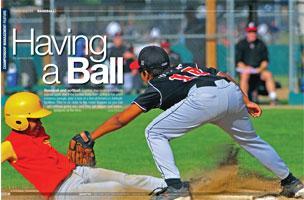
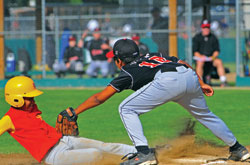 |
| © Jim Boardman - Dreamstime.com |
Baseball and softball: together, they're America's most popular sport. And if the packed fields from spring to fall aren't evidence enough, take a look at a few of America's fantastic facilities. They're as close to the major leagues as you can get without going pro, and they get bigger and better-designed all the time.
Inspired Beginnings
Baseball has inspired countless young athletes, and we know its story well: born in Cooperstown; Ty Cobb; the 1919 World Series scandal; Lou Gehrig; Babe Ruth; Joe DiMaggio. There's the All-American Girls Professional Baseball League,popularized by the film "A League of Their Own," but for the most part, the history of baseball is about men.
But as it turns out, the lesser-known story of softball has a lot to do with inspiration as well-it's a story about using all the resources at hand to create something exciting and fun. That's how softball started, and how America came to be home to so many fine baseball and softball facilities as well.
Softball Gets Its Start
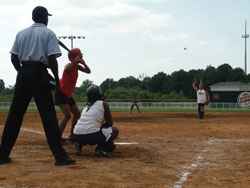 |
| Veterans Softball Complex. Photo courtesy of Tupelo Convention and Visitors Bureau. |
Softball owes its beginnings to a couple of surprising sports: football and boxing. One cold winter day in 1887, upon hearing the news that Yale had defeated the Harvard football team, a spirited Yale fan threw a boxing glove at a Harvard fan, who hit it back with a stick. Chicago Board of Trade reporter George Hancock watched with interest, and then suggested a new game-indoor baseball. He and his friends tied up that boxing glove to make a "soft" ball and launched what would become America's number one participatory sport.
Today, more than 4 million softball players are members of the Amateur Softball Association (ASA), which is the sport's national governing body (NGB) and sanctions competition in every state. ASA is one of the largest softball organizations, but a number of other organizations-including, but not limited to, the National Softball Association (NSA), the United States Specialty Sports Association (USSSA), the Amateur Athletic Union (AAU) and Little League International-organize softball (and, in some cases, baseball) teams and events as well.
USA Baseball has served as baseball's NGB since 1978 and is also the umbrella organization governing nearly every major national amateur baseball organization in America. As a result, USA Baseball serves more than 12 million amateur players across the country.
Facilities
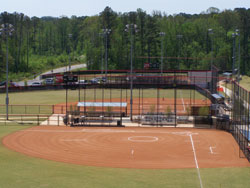 |
| Twin Creeks Softball Complex. Photo courtesy of Cherokee County Parks & Recreation |
While softball and baseball are similar in many ways, the facilities where they are played have some major differences. Field size,the distances between the pitcher's mound and home plate and the distances between bases, all vary depending on which sport is being played and the age of the players. For this reason, many communities, particularly those with highly competitive teams, construct complexes specifically for each sport. As a result, it's easy to find the ideal facility for athletes of any age, size or skill level.
Long Island, New York
It turns out baseball nirvana is only an hour outside of New York City. Baseball Heaven is a state-of-the-art facility, built with the idea of giving the sport's smallest players a big league experience. Equipped with all the amenities of a professional ballpark, including below-grade dugouts, connecting bullpens, warning tracks, P.A. system and electronic scoreboards, Baseball Heaven's seven-field complex even boasts Sportfield artificial turf, the same turf chosen for the Dallas Cowboys Stadium.
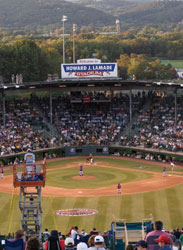 |
| Little League World Series. Photo courtesy of Lycoming County Visitors Bureau |
Baseball Heaven invites both players and spectators to enjoy a Big Show experience, with ballpark seating, concessions, the Baseball Cafe and picnic area. All this, and Baseball Heaven has location on its side too. Between games, families can take advantage of New York City's endless excitement or settle into one of Long Island's beautiful beaches.
San Bernardino, California
Thanks to Little League International, millions of children on six continents have had the chance to experience the team spirit of baseball and softball. In the Little League Western Region, Jim Gerstenslager, Western Region director, and his team make sure that as many kids as possible get a taste of the baseball/softball experience too.
"We've got a great facility: 26.5 acres with two stadiums, a 60-foot little league field and a 90-foot regulation field," says Gerstenslager. "We've also got batting cages, offices, a conference room, full kitchen and dining room, seven dormitories that house two teams each, housing for nurses and umpires, even an Olympic swimming pool. And of course, we've got a lot of parking."
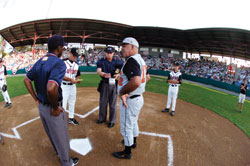 |
| Historic Bowman Field - Williamsport Crosscutters Game. Photo courtesy of Lycoming County Visitors Bureau |
The Western Region Headquarters host their primary event each August: the Western Region Tournament, which decides who goes on to the Little League World Series in Williamsport, Pennsylvania.
In addition, both girls and boys get play time at the Western Region Little League Center. While the Center hosts play for both baseball and softball, girls, typically in the 12-and-under levels, can play on Little League baseball teams as well as softball.
Williamsport, Pennsylvania
The birthplace of Little League and home to the Little League World Series, Williamsport is also, not surprisingly, home to several first-rate baseball and softball facilities.
Historic Bowman Field is America's 2nd oldest minor league stadium, featuring seating for 4,200, professional lighting, a covered hitting tunnel, two bullpens and a 180-seat picnic deck. Home of the Williamsport Crosscutters, Bowman Field recently hosted USA Softball's Bound 4 Beijing tour.
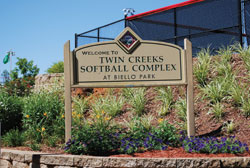 The Generations Sports Dome Complex is America's largest fully air-supported dome, encompassing 135,000 square feet, including 96,000 square feet of state-of-the-art Astro Play field turf. Depending on event needs, the Complex can be divided into three separate fields, or used as one large space, and is equipped with a conference room, concession stands and fitness area. Host to the Jennie Finch Softball Camp, which gives girls the opportunity to train with Olympic softball players, the Complex offers an elite experience for softball, baseball and a variety of other sports.
The Generations Sports Dome Complex is America's largest fully air-supported dome, encompassing 135,000 square feet, including 96,000 square feet of state-of-the-art Astro Play field turf. Depending on event needs, the Complex can be divided into three separate fields, or used as one large space, and is equipped with a conference room, concession stands and fitness area. Host to the Jennie Finch Softball Camp, which gives girls the opportunity to train with Olympic softball players, the Complex offers an elite experience for softball, baseball and a variety of other sports.
Woodstock, Georgia
Voted the 2008 ASA Complex of the Year, Twin Creeks Softball Complex in Woodstock is a spectacular facility dedicated solely to softball play. Built on land leased from the Army Corps of Engineers, Twin Creeks opened in 2006, becoming Cherokee County's first youth softball complex.
"Since the complex opened, our softball numbers have tripled," says Keith Hammond, director, Cherokee County Parks & Recreation. "People want to play at Twin Creeks. They're willing to drive a little farther even to get to."
Part of a larger, 470-acre park, Twin Creeks is a five-field complex built to fast pitch specifications. The facility features a unique layout as well. Rather than the typical wagon wheel layout, which arranges fields in a circular pattern, Twin Creeks' fields are arranged in pairs along a walkway that leads through the park.
"We've received huge compliments about the complex," says Hammond. "Rarely do you go to a complex that's built strictly for girls' fast pitch, and people really enjoy the layout and park-like setting."
In addition to a wide variety of ASA tournaments, Southeast regionals, and a college scout exposure tournament, Twin Creeks is the host site for Woodstock's annual youth classic, now in its 20th year. In just four years, the facility has hosted more than 100 teams, and with plans to build three more fields in the coming years, Twin Creeks is just getting started.
Minnetonka, Minnesota
Some parks have new, flashy facilities; other parks have a rich history. And in some cases, like Bennett Family Park, you get both. Mayor Bud Robb of Deephaven threw out the Park's first pitch in 1957, and today Bennett Family Park is a five-field baseball and softball facility serving 1,400 athletes annually. In 2009, the Park got a renovation that not only brought the historic complex up to state-of-the-art standards; it also made it possible for any child who wants to play to enjoy the game of baseball.
"We were approached four years ago by the Miracle League of Minnesota, who wanted to put a Miracle League Field at Bennett Family Park, "says Bob Jasper, director, long range planning, Bennett Family Park Board of Directors. "We got excited about building this field, so we looked at what renovations would be required to put a Miracle Field at Bennett, such as a parking lot and facility renovations, as well as the actual field. The total was about $1.2 million."
It sounds impossible, especially in the current economy, but with guidance and help from Minnesota's West Metro Miracle League, Jasper and the Bennett Family Park team raised every cent of the $1.2 million and completed the construction and renovations without ever taking out a loan.
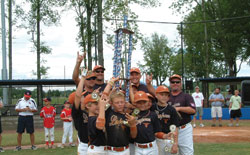 |
| 2009 Dizzy Dean World Series. Photo courtesy of Tupelo Convention and Visitors Bureau. |
Miracle at Bennett is a 110-foot field with a half-inch rubber surface poured on asphalt. The surface, which offers an extra level of athlete protection, is painted brown in the place of a traditional field's dirt and green in the place of grass. The bases are also flat, making it easy for wheelchairs and walkers to navigate the surface. But more than just the physical changes that the Miracle Field has brought to Bennett Family Park, the Miracle League has made a positive mark on everyone who plays at the field.
"These same kids go to athletic event after athletic event for their siblings and watch. Now they get to play, and their brothers and sisters cheer them on," says Jasper. "The buddy experience, where kids and adults volunteer to help the Miracle League kids play, has made a huge impact too. It's been terrific for us, and we're only just beginning to understand how terrific."
Tupelo, Mississippi
Tupelo may be the home of Elvis' birthplace, but it's also home to some serious baseball and softball facilities. Tupelo's nine-field Sportsplex opened in 2008 in the 153-acre Ballard Park and has hosted multiple invitational, state and national tournaments, including the 40-plus team BNA Bank Invitational and the Dizzy Dean 12-year-old World Series.
And even though Sportsplex is a new facility, that doesn't mean it isn't always improving. "The parents' association, along with the parks and recreation department, just purchased some new shade units for the bleachers," says Neal McCoy, deputy director, Tupelo Convention and Visitors Bureau. "That was a $50,000 investment, and a really important one, considering our Mississippi summers."
Located in South Tupelo, Theron Nichols Park is a three-field complex that serves as an overflow facility for larger events at the Sportsplex. Open since 2008, Theron Nichols Park gives Tupelo the ability to accommodate large events with ease.
Veterans Memorial Park and Eastwood Softball Complex are Tupelo's softball facilities, and just like Tupleo's baseball facilities, Veterans Memorial Park is staying on top with regular updates-the Park's fields all recently received infield renovations. These fields have hosted over 20 national ASA and USSSA softball events, as well as two large adult events, the Gumtree and Starkvegas Invitationals.
Finding the Right Facility
As two of America's most popular sports, baseball and softball have inspired countless young athletes and inspired the construction of facilities that are almost as countless. So how do you find the right facility for your event? Mike Parent, president of H&K Sports Fields, a sports field design, construction and renovation company, has a few ideas to get you started:
Quality. Players want to play on the best possible field, which means good quality turf and good materials throughout.
Design. Look for a professional quality infield with a top dressing material that will improve playability and help prevent rain delays by promoting drainage and drying.
Safety. You want safe players, but also safe fans, so look for proper screening and netting, as well as lighting, particularly in the parking lots and walkways between fields.
Choice. It's a new and still somewhat rare trend, but look for facilities that offer healthy food choices. It's better for the athletes and adds an educational nutritional component as well.

